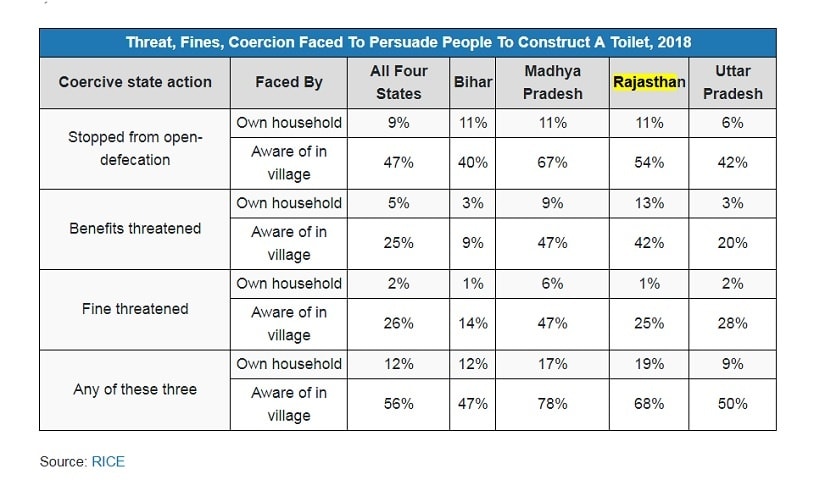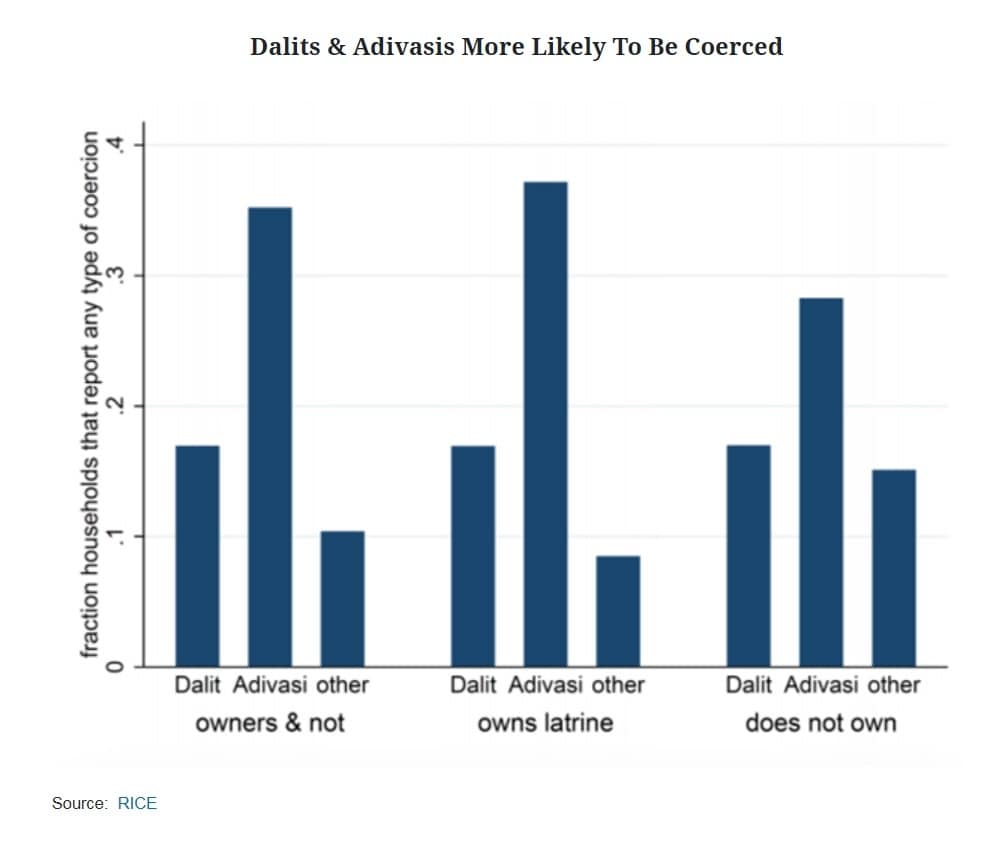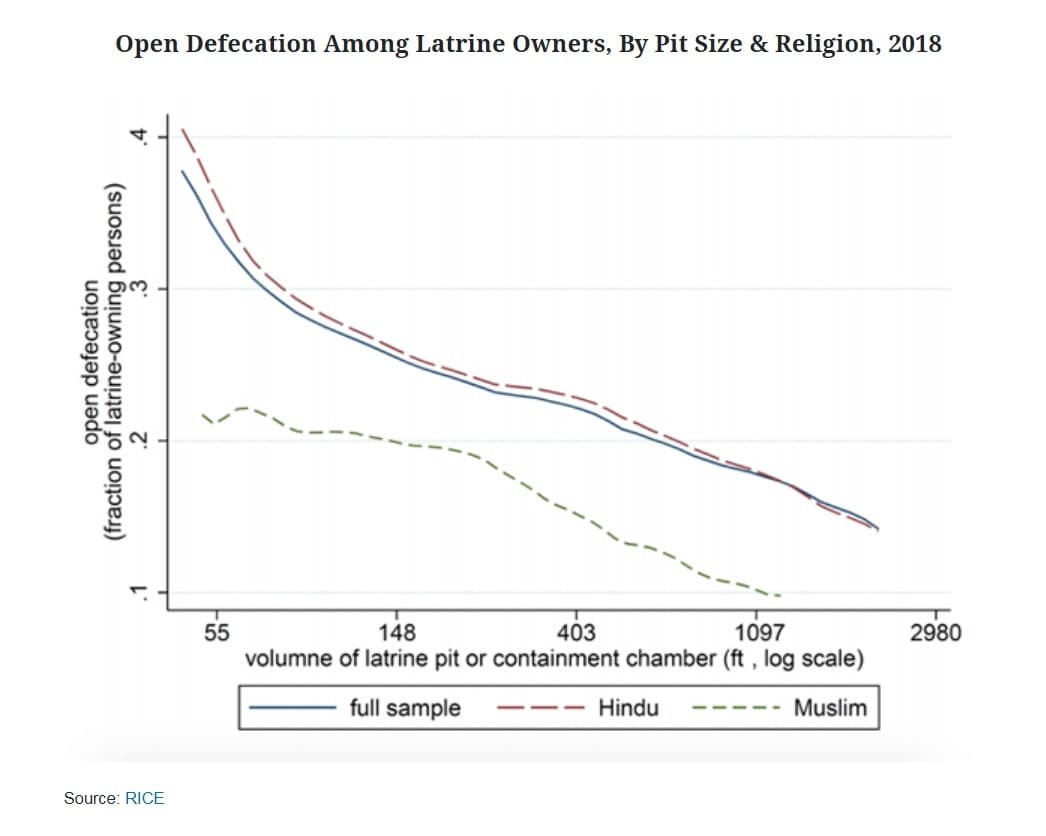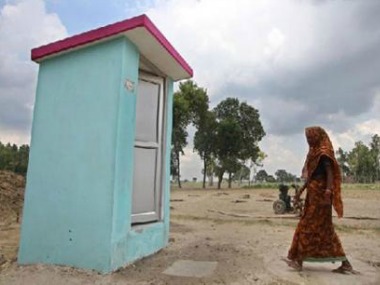New Delhi: More Indians living in villages owned a latrine in 2018 than four years ago, yet 44 percent of them still defecate in the open, according to a survey covering Rajasthan, Bihar, Madhya Pradesh and Uttar Pradesh that was released on 4 January. These four states together contain two-fifths of India’s rural population and reported high open defecation rates, over 68 percent in 2016, as per this government
report. Almost a quarter (23 percent) of those who own a latrine defecated in the open, a figure that has remained unchanged since 2014, researchers found. This can mostly be attributed to deeply entrenched beliefs about caste “impurity” associated with emptying latrine pits, the paper concluded. “Changes in open defecation in rural North India: 2014-2018”, a working
paper published by the research and policy advocacy
Research Institute for Compassionate Economics (RICE) and New Delhi-based policy think tank
Accountability Initiative (AI), is based on surveys of over 9,812 people and 156 government officials in 2018. [caption id=“attachment_3873293” align=“alignleft” width=“380”] Representational image. News18[/caption] The researchers first visited these participants in October 2014, a few months before the launch of India’s national sanitation programme
Swachh Bharat Mission (SBM) or Clean India Mission. In August 2018, they revisited them to gauge the impact of the mission. Observations from AI’s 2017
survey in Udaipur, Rajasthan were also added to the survey. We emailed secretary, Ministry of Drinking Water and Sanitation, in-charge of the Swachh Bharat Mission (rural) for a response to the findings of the paper. We will update the article when we get a response. There has been a decrease of 26 percentage points in open defecation since 2014, when 70 percent of people did not use toilets, as per the study. By 2018, almost 57 percent of households without a latrine in 2014 had acquired one. However, there was a problem with the new structures: Most were based on the single-pit design, not the twin-pit one the government recommended. The twin-pit design allows decomposition of faecal sludge in one pit while the other is being used, providing a safe way of emptying it. Single pits require undecomposed sludge to be emptied manually or through expensive suction machines. The Swachh Bharat campaign was largely focused on latrine construction, and it did little to address attitudes to latrine pits, rooted in notions of purity and pollution, said Aashish Gupta, research fellow at RICE, PhD candidate at the University of Pennsylvania, and the lead author of the paper. “Consequently, while toilet coverage increased, open defecation among toilet owners did not decline,” he said. A FactChecker.in investigation in
Gujarat and
Uttar Pradesh in 2018 also found fudged data and unusable, poor quality toilets with high open defecation. Rajasthan, Madhya Pradesh not open defecation-free yet, contrary to claims Rajasthan and Madhya Pradesh, two states that had
declared themselves open defecation-free, have yet to achieve that goal. In Rajasthan and Madhya Pradesh, 53 percent and 25 percent, respectively, were estimated to be defecating in the open. Open defecation had not been eliminated in any of the districts surveyed in North India, researchers said. This is despite a “rapid” decline of almost 6 percentage points in open defecation rate every year, as per the paper. “The government is both overselling its claim and not measuring what needs to be measured [open defecation],” said Gupta. There has been 34-percentage-point increase in latrine ownership in North India from 37 percent in 2014 to 71 percent in 2018. The highest difference was reported in Madhya Pradesh and Rajasthan — 47 percentage points.
However, the survey found 40 percent of households with a latrine and 56 percent of all households had at least one family member defecating in the open. Bihar at 60 percent and Rajasthan at 53 percent led the four-state open defecation list. Madhya Pradesh had the lowest rate — 25 percent. Researchers analysed the results and found that the decrease in open defecation rate in the past four years was driven not by behaviour change but was the result of increased latrine ownership. This is the also reason that the 23 percent of latrine owners who defecated in the open unchanged from 2014 to 2018. “This finding is consistent with our qualitative interviews, which found that local officials were far more likely to stress latrine construction as a priority of the SBM than they were to stress use of latrines,” noted the paper. Self-constructed latrines more likely to be used Of the 57 percent of participants who built a latrine during the four years covered by the survey, 42 percent got some kind of government support. Also, an average of 17 percent of these latrines were built by the government or a contractor. The number of contractor-built structures was the highest in Madhya Pradesh (33 percent), followed by Uttar Pradesh (22 percent). [caption id=“attachment_5861851” align=“alignnone” width=“968”] Latrine ownership and support from government in 2018. Source: RICE[/caption] It matters who built the latrines: Contractor-built latrines were generally of poorer quality and it was found that households that built their own latrines were 10 percentage points more likely to use them than others. The paper found most contractor-built latrines were in Adivasi households which could be because these were poorer and unlikely to spend their own money on toilet construction. Also, corrupt contractors have an easier time skimming funds in Adivasi areas, it was alleged in the paper. Manually scavenged single pits still preferred Most toilets built (40 percent) had single pits, while twin pits were observed in only 25 percent of latrines. Moreover, 31 percent of the latrines had a containment chamber which meant they had to be emptied by a suction machine and was the most expensive of all toilet designs. However, in the latrines that were supported by the government, the twin pit was the design of choice especially in Uttar Pradesh where 61 percent of latrines had this design. One reason for this could be that people could access a government subsidy of Rs 12,000 if they opted for a twin pit. Local government officials admitted in interviews to researchers that most villagers preferred containment chambers and 48 percent latrine owners with twin pits said that both the pits were used at the same time, defeating the idea of the sustainable design. Adivasis, Dalit households more likely to face threats, fines In all four states, 56 percent of respondents said they were aware of coercive methods — fines, threat of denial of benefits, stopped from open defecation — used to persuade people to construct a latrine. In Madhya Pradesh and Rajasthan, 47 percent and 42 percent of respondents, respectively, had heard of government benefits being denied to those without latrines. “Instead of challenging caste, Swachh Bharat Mission ended up reinforcing it,” said Gupta. This is because while the programme used community-led total sanitation approach of creating a demand in the community, it overlooked the fact that Indian villages are highly divided among caste lines, he added. [caption id=“attachment_5861871” align=“alignnone” width=“825”]
 Threats, fines, coercion faced to persuade people to construct a toilet in 2018. Source: RICE[/caption] In all four states, among households that owned a latrine, Dalit households were twice as likely, and Adivasi households thrice, to face coercive practices compared to other social groups. They were more likely to face threats irrespective of whether or not they owned a latrine, the survey showed. [caption id=“attachment_5861921” align=“alignnone” width=“1007”]
Threats, fines, coercion faced to persuade people to construct a toilet in 2018. Source: RICE[/caption] In all four states, among households that owned a latrine, Dalit households were twice as likely, and Adivasi households thrice, to face coercive practices compared to other social groups. They were more likely to face threats irrespective of whether or not they owned a latrine, the survey showed. [caption id=“attachment_5861921” align=“alignnone” width=“1007”] Dalits and Adivasis more likely to be coerced. Source: RICE[/caption] Also, those who were coerced into constructing a latrine were less likely to use the latrine. Most local officials did not think these measures were inappropriate or excessive. They relied on these measures to reach the toilet construction target in an ‘unreasonably short time’, the researchers noted. Taboos linked with idea of ‘purity’ still rampant Researchers found Hindu households with latrines were more likely to defecate in the open than Muslim households. Also, Hindu households with larger pits were less likely to defecate in the open than those with smaller pits. This could be because smaller pits require frequent emptying, which is associated with ‘caste impurity’. [caption id=“attachment_5861841” align=“alignnone” width=“1046”]
Dalits and Adivasis more likely to be coerced. Source: RICE[/caption] Also, those who were coerced into constructing a latrine were less likely to use the latrine. Most local officials did not think these measures were inappropriate or excessive. They relied on these measures to reach the toilet construction target in an ‘unreasonably short time’, the researchers noted. Taboos linked with idea of ‘purity’ still rampant Researchers found Hindu households with latrines were more likely to defecate in the open than Muslim households. Also, Hindu households with larger pits were less likely to defecate in the open than those with smaller pits. This could be because smaller pits require frequent emptying, which is associated with ‘caste impurity’. [caption id=“attachment_5861841” align=“alignnone” width=“1046”] Open defecation among latrine owners. Source: RICE[/caption] To accommodate bigger pits, households that built their own toilet, on average, spent Rs 34,000 — nearly three times the government subsidy of Rs 12,000. This difference explains why households had to be coerced into building a latrine, said researchers. Efforts to spread awareness about the twin-pit design and sustainable and affordable faecal sludge management — the
video campaign featuring actor Akshay Kumar emptying a latrine is one example — were not sufficiently prominent, said the paper. “To end open defecation, coercive tactics should end. Instead, latrine use should be encouraged alongside efforts to transform the social attitudes that have made open defecation so challenging to change,” Gupta said. The author is a principal correspondent with IndiaSpend
Open defecation among latrine owners. Source: RICE[/caption] To accommodate bigger pits, households that built their own toilet, on average, spent Rs 34,000 — nearly three times the government subsidy of Rs 12,000. This difference explains why households had to be coerced into building a latrine, said researchers. Efforts to spread awareness about the twin-pit design and sustainable and affordable faecal sludge management — the
video campaign featuring actor Akshay Kumar emptying a latrine is one example — were not sufficiently prominent, said the paper. “To end open defecation, coercive tactics should end. Instead, latrine use should be encouraged alongside efforts to transform the social attitudes that have made open defecation so challenging to change,” Gupta said. The author is a principal correspondent with IndiaSpend


)

)
)
)
)
)
)
)
)



